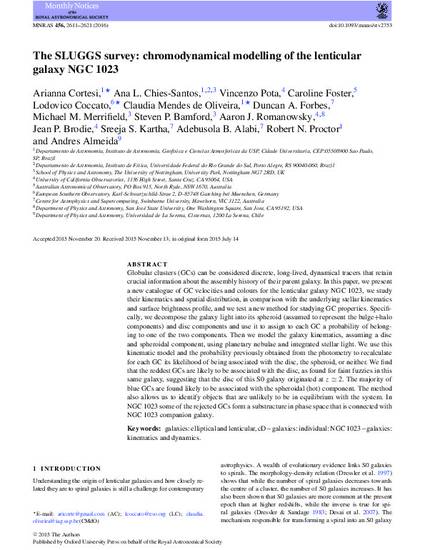
Article
The SLUGGS survey: chromodynamical modelling of the lenticular galaxy NGC 1023
Monthly Notices of the Royal Astronomical Society
(2016)
Abstract
Globular clusters (GCs) can be considered discrete, long-lived, dynamical tracers that retain crucial information about the assembly history of their parent galaxy. In this paper, we present a new catalogue of GC velocities and colours for the lenticular galaxy NGC 1023, we study their kinematics and spatial distribution, in comparison with the underlying stellar kinematics and surface brightness profile, and we test a new method for studying GC properties. Specifically, we decompose the galaxy light into its spheroid (assumed to represent the bulge+halo components) and disc components and use it to assign to each GC a probability of belonging to one of the two components. Then we model the galaxy kinematics, assuming a disc and spheroidal component, using planetary nebulae and integrated stellar light. We use this kinematic model and the probability previously obtained from the photometry to recalculate for each GC its likelihood of being associated with the disc, the spheroid, or neither. We find that the reddest GCs are likely to be associated with the disc, as found for faint fuzzies in this same galaxy, suggesting that the disc of this S0 galaxy originated at z ≃ 2. The majority of blue GCs are found likely to be associated with the spheroidal (hot) component. The method also allows us to identify objects that are unlikely to be in equilibrium with the system. In NGC 1023 some of the rejected GCs form a substructure in phase space that is connected with NGC 1023 companion galaxy.
Keywords
- galaxies: elliptical and lenticular,
- cD,
- galaxies: individual: NGC 1023,
- galaxies: kinematics and dynamics
Disciplines
Publication Date
March, 2016
DOI
10.1093/mnras/stv2753
Publisher Statement
This article has been accepted for publication in Monthly Notices of the Royal Astronomical Society ©: 2015 The Authors. Published by Oxford University Press on behalf of the Royal Astronomical Society. All rights reserved.
This article is also available online at the following link: http://dx.doi.org/10.1093/mnras/stv2753
Citation Information
Arianna Cortesi, Ana L. Chies-Santos, Vincenzo Pota, Caroline Foster, et al.. "The SLUGGS survey: chromodynamical modelling of the lenticular galaxy NGC 1023" Monthly Notices of the Royal Astronomical Society Vol. 456 Iss. 3 (2016) p. 2611 - 2621 ISSN: 1365-2966 Available at: http://works.bepress.com/aaron_romanowsky/89/
